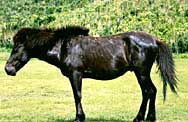Tokara
N/A
Mon, 25th November, 2024 - 7:52 am GMT
Sponsor Ads:

Alternative Name
N/ABasic Info
It stands 12 h.h.
Health
N/AHabitat
N/ABehavior
It is used for riding and light draft. They were used for farming, transportation of heavy objects, and in processing sugarcane grown in the area. In 1943, at the height of their popularity, the breed reached 100 head, but after World War II their numbers were reduced drastically. Kagoshima Prefecture declared the ponies a prefectural national monument and sent them to the mainland for a time because of the difficult living conditions on the island. Today Kagoshima University, Iriki ranch, Kaimon National Park, and Nakano Island in the Tokara Islands are the centers for breeding and preservation of the Tokara pony. As of December 1988, a total of eighty-eight purebred animals remained. Population Status: RareOrigin
JapanHistory
These horses which are today found in several natural parks in Kagoshima Prefecture are the descendents of two dozen native horses brought to Kyushu from Kikai Shima about 1890. The breed was bred on Tokara Island and at one time was quite numerous throughout the Kagoshima region. However, the numbers decreased drastically during World War II and the breed was preserved only by strenuous efforts. The resulting horses have, under more care and selective breeding, bIn an attempt to preserve the breed in a near original form a number of animals have been taken to Nakanoshima in the Tokara island where they range freely during the year and are rounded up for pest extermination, inoculation and veterinary treatment once a year. The breed has been designated a Prefectural Natural Treasure. The are today 116 head of the Tokara breed. Early in 1950, Dr. Shigeyuki Hayashida found a group of small horses living in the south side of the Tokara Islands and named they Tokara ponies. According to this man, around 1897 people from Kitaiga Island brought about ten native horses to Takara (not Tokara).Common Foods
grassSponsor Ads:
The whole of life is futile unless you regard it is a sporting proposition. -- Unknown
Tokara
Coded by: BGID® | ALL RIGHTS RESERVED Copyright © 2000-2024
Disclaimer | Privacy | Report Errors / Contact | Credits








 President of the United States of America - Real Estate mogul, Pageant owner and now one of the most controversial men in political history.
President of the United States of America - Real Estate mogul, Pageant owner and now one of the most controversial men in political history.  Politician, US Vice President and President of the USA - Joseph Robinette Biden Jr.
Politician, US Vice President and President of the USA - Joseph Robinette Biden Jr.  versus
versus  Russia: 'The Evil Empire'? Are they all that bad or is it just the USA trying to portray Russia as bad because they are a world power with land bigger and a society very different from the USA ideal?
Russia: 'The Evil Empire'? Are they all that bad or is it just the USA trying to portray Russia as bad because they are a world power with land bigger and a society very different from the USA ideal?  Global warming has been in and out as the "latest" hot topic for many years. It is, according to modern scientists, the result of man-made industrial pollutants, clearing forested areas, agriculture, etc. But now they are thinking it started way before the Industrial Revolution...
Global warming has been in and out as the "latest" hot topic for many years. It is, according to modern scientists, the result of man-made industrial pollutants, clearing forested areas, agriculture, etc. But now they are thinking it started way before the Industrial Revolution... 
 Corona virus
Corona virus 
 Users with wide screen monitors can benefit from more content on every page.
Users with wide screen monitors can benefit from more content on every page.